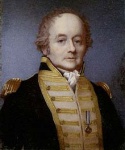A wooden figurehead from a Royal Navy ship which went into battle in 1854 has been given protected status.
The figurehead of a woman from HMS Arethusa, which is described as a ‘rare survivor’ from the Crimean War, has been listed at Grade II by the Culture Department on the advice of its heritage agency, Historic England.
It is one of only five listed figureheads in England that are not incorporated into listed buildings, and giving it protected status means the carving's story will not be lost, said Historic England.
HMS Arethusa, named after a sea nymph from Greek mythology who fled her home in Arcadia under the sea and came up as a fresh water fountain in Sicily, was commissioned into the Royal Navy in 1849.
The 50-gun fourth rate sailing frigate was the last major ship of the Royal Navy to enter an engagement under sail power alone.
She was decommissioned in 1874 and became a training ship and boarding school, moored in Kent and run by a charity, for 250 destitute boys who were taught maritime skills to prepare them for service in the Royal or Merchant Navies.
Her figurehead, carved by James Hellyer & Sons of London and Portsmouth, who had a long tradition as ships' carvers, is an 11.5ft (3.5m) painted female bust with brown ringlets and loose early Victorian robes.
The figurehead's right breast is exposed, in keeping with the 19th century belief that a naked woman was be able to calm a storm at sea.
The charity, now known as Shaftesbury Young People, retained the figurehead when the Arethusa was found to no longer be viable and was sold to ship-breakers in 1933.
It displayed the figurehead at its onshore premises at Lower Upnor, Rochester, which has since been developed into the Arethusa Venture Centre with the figurehead at its front, facing the River Medway.
Heritage Minister Michael Ellis said: ‘HMS Arethusa's figurehead is a rare survivor of the Crimean War and an important symbol of Britain's maritime heritage.
‘By protecting it, we are ensuring that an important part of the country's seafaring history is preserved for future generations.’
Duncan Wilson, chief executive of Historic England, said: ‘The survival of former bow figureheads as statues helps demonstrate the rich and colourful history of our maritime past.







 Reply With Quote
Reply With Quote
Bookmarks